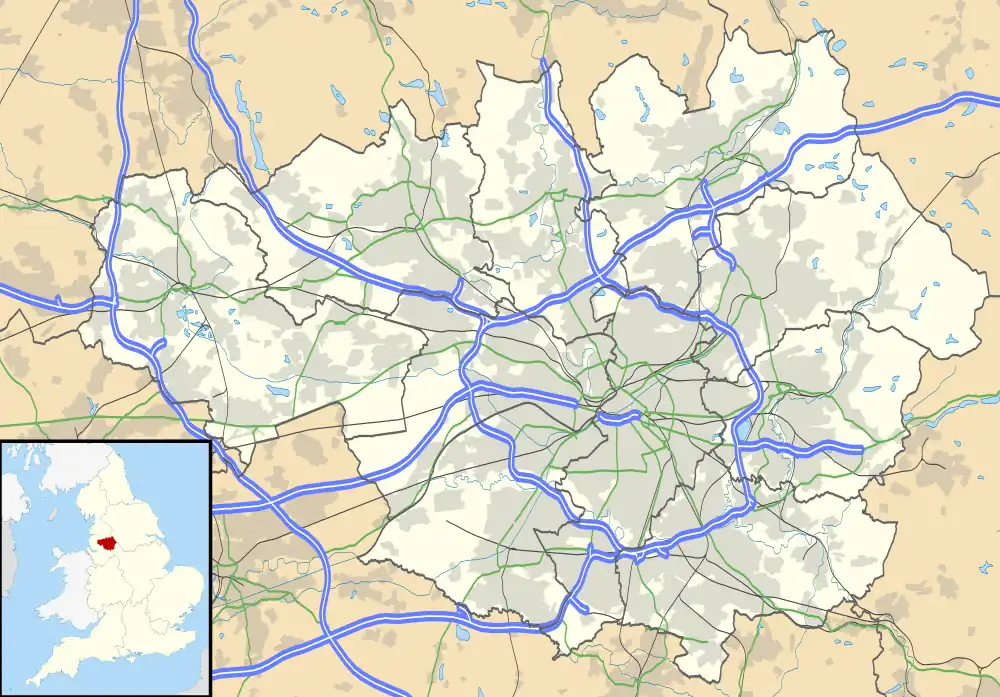| Ashton upon Mersey | |
|---|---|
 | |
 Ashton upon Mersey Location within Greater Manchester | |
| Population | 9,693 (2011) |
| OS grid reference | SJ785925 |
| • London | 162 mi (261 km) SE |
| Metropolitan borough | |
| Metropolitan county | |
| Region | |
| Country | England |
| Sovereign state | United Kingdom |
| Post town | SALE |
| Postcode district | M33 |
| Dialling code | 0161 |
| Police | Greater Manchester |
| Fire | Greater Manchester |
| Ambulance | North West |
| UK Parliament | |
Ashton upon Mersey is an area of the Metropolitan Borough of Trafford, Greater Manchester, England, with a population of 9,693 at the 2011 census.[1] It lies on the south bank of the River Mersey, 5 miles (8.0 km) south of Manchester city centre.
Historically part of Cheshire, it became an urban district in 1895 under the Local Government Act 1894. In 1930, the Ashton upon Mersey urban district was abolished and the area became a part of the urban district of Sale.[2] It was part of the Borough of Sale, Cheshire, until 1974.
History
A 4th century hoard of 46 Roman coins was discovered and is one of four known hoards dating from that period discovered within the Mersey basin.[3][4] In the 18th century, it was thought that Ashton upon Mersey might have been the site of Fines Miaimae et Flaviae, a Roman station next to the River Mersey. However, this was based on the De Situ Britanniae, a manuscript forged by Charles Bertram, and there is no evidence to suggest any such station existed.[5] "Ashton" is Old English for "village or farm near the ash trees", suggesting that Ashton upon Mersey is of Anglo-Saxon origin.[6] The township is first mentioned in 1260.[7] The first building of St. Martin's Church dated from 1304, but a Chantry on the same site is believed to have existed since the 9th Century. Ashton-on-Mersey School is located in the area.
Notable citizens
- Lascelles Abercrombie (1881–1938), poet and professor of English[8]
- Sir Patrick Abercrombie (1879–1957), architect, noted for the redevelopment of post-war London[9]
- Stanley Houghton (1881–1913), playwright and author of Hindle Wakes[10]
- Vincent James, animator and cartoonist, best known work on Count Duckula and Philbert Frog[11]
- Karl Pilkington (b. 1972), author and radio and TV personality[12]
- Andy Rourke (1964–2023), bassist of the Smiths[13]
- Chris Sievey (1955–2010), better known for his comic persona Frank Sidebottom[14]
See also
References
- Notes
- ↑ "Trafford ward population". Retrieved 8 January 2016.
- ↑ "Ashton upon Mersey UD". A vision of Britain through time.
- ↑ Nevell (1992), pp. 59, 75.
- ↑ Nevell (1997), p. 20.
- ↑ Swain (1987), pp. 9–10.
- ↑ Swain (1987), pp. 12–13.
- ↑ Nevell (1997), p. 32.
- ↑ "Lascelles Abercrombie". britannica.com. Britannica. 20 July 1998. Retrieved 5 January 2024.
- ↑ "Sir Patrick Abercrombie". britannica.com. Britannica. 20 July 1998. Retrieved 5 January 2024.
- ↑ "Stanley Houghton Collection". salford.ac.uk. University of Salford. Retrieved 5 January 2024.
- ↑ "Ashton-on-Mersey animator Vincent James nominated for Children's BAFTA". Messenger. 22 November 2011. Retrieved 5 January 2024.
- ↑ Devlin, Wayne (31 May 2018). "Wayne's World: Karl Pilkington on growing up in Trafford". Messenger. Retrieved 5 January 2024.
- ↑ Stokes, Paul (19 May 2023). ""The Smiths Were A Gang. A Band Of Brothers…" Andy Rourke Interviewed". mojo4music.com. Mojo. Retrieved 5 January 2024.
- ↑ Hughes, Rob (22 June 2010). "Chris Sievey obituary". The Guardian. Retrieved 5 January 2024.
- Bibliography
- Nevell, Mike (1992). Tameside Before 1066. Tameside Metropolitan Borough Council. ISBN 1-871324-07-6.
- Nevell, Mike (1997). The Archaeology of Trafford. Trafford Metropolitan Borough Council. ISBN 1-870695-25-9.
- Swain, Norman (1987). A History of Sale from earliest times to the present day. Wilmslow: Sigma Press. ISBN 1-85058-086-3.